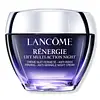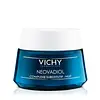What's inside
What's inside
 Key Ingredients
Key Ingredients

 Benefits
Benefits

 Concerns
Concerns

 Ingredients Side-by-side
Ingredients Side-by-side

Water
Skin ConditioningGlycerin
HumectantPrunus Armeniaca Kernel Oil
MaskingCaprylic/Capric Triglyceride
MaskingPentaerythrityl Tetraethylhexanoate
EmollientCetyl Alcohol
EmollientZea Mays Starch
AbsorbentButyrospermum Parkii Butter
Skin ConditioningAlcohol Denat.
AntimicrobialPetrolatum
EmollientPentylene Glycol
Skin ConditioningGlyceryl Stearate
EmollientDimethicone
EmollientPEG-40 Stearate
EmulsifyingCera Alba
EmollientHydroxyethylpiperazine Ethane Sulfonic Acid
BufferingCI 14700
Cosmetic ColorantCI 19140
Cosmetic ColorantSaccharomyces/Xylinum/Black Tea Ferment
Skin ConditioningHydrolyzed Linseed Extract
Skin ConditioningHydrolyzed Soy Protein
HumectantHydrolyzed Hyaluronic Acid
HumectantSodium Hydroxide
BufferingSodium Benzoate
MaskingPhenoxyethanol
PreservativeAdenosine
Skin ConditioningStearyl Alcohol
EmollientAcetyl Tetrapeptide-9
Skin ConditioningPoloxamer 338
EmulsifyingDimethiconol
EmollientLimonene
PerfumingXanthan Gum
EmulsifyingPentaerythrityl Tetra-Di-T-Butyl Hydroxyhydrocinnamate
AntioxidantBenzyl Alcohol
PerfumingCaprylyl Glycol
EmollientAlpha-Isomethyl Ionone
PerfumingSorbitan Tristearate
EmulsifyingMyristyl Alcohol
EmollientGeraniol
PerfumingHexyl Cinnamal
PerfumingParfum
MaskingWater, Glycerin, Prunus Armeniaca Kernel Oil, Caprylic/Capric Triglyceride, Pentaerythrityl Tetraethylhexanoate, Cetyl Alcohol, Zea Mays Starch, Butyrospermum Parkii Butter, Alcohol Denat., Petrolatum, Pentylene Glycol, Glyceryl Stearate, Dimethicone, PEG-40 Stearate, Cera Alba, Hydroxyethylpiperazine Ethane Sulfonic Acid, CI 14700, CI 19140, Saccharomyces/Xylinum/Black Tea Ferment, Hydrolyzed Linseed Extract, Hydrolyzed Soy Protein, Hydrolyzed Hyaluronic Acid, Sodium Hydroxide, Sodium Benzoate, Phenoxyethanol, Adenosine, Stearyl Alcohol, Acetyl Tetrapeptide-9, Poloxamer 338, Dimethiconol, Limonene, Xanthan Gum, Pentaerythrityl Tetra-Di-T-Butyl Hydroxyhydrocinnamate, Benzyl Alcohol, Caprylyl Glycol, Alpha-Isomethyl Ionone, Sorbitan Tristearate, Myristyl Alcohol, Geraniol, Hexyl Cinnamal, Parfum
Water
Skin ConditioningGlycerin
HumectantPrunus Armeniaca Kernel Oil
MaskingAlcohol Denat.
AntimicrobialDimethicone
EmollientHydroxypropyl Tetrahydropyrantriol
Skin ConditioningPropanediol
SolventPropylene Glycol
HumectantIsononyl Isononanoate
EmollientZea Mays Starch
AbsorbentHydroxyethylpiperazine Ethane Sulfonic Acid
BufferingAmmonium Acryloyldimethyltaurate/Steareth-25 Methacrylate Crosspolymer
Emulsion StabilisingAmmonium Polyacryloyldimethyl Taurate
Emulsion StabilisingC13-14 Isoparaffin
EmollientCaffeine
Skin ConditioningCaprylyl Glycol
EmollientCI 42090
Cosmetic ColorantDextrin
AbsorbentDimethiconol
EmollientDisodium EDTA
Eperua Falcata Bark Extract
Skin ProtectingLaureth-7
EmulsifyingMethyldihydrojasmonate
MaskingPentaerythrityl Tetra-Di-T-Butyl Hydroxyhydrocinnamate
AntioxidantPerlite
AbsorbentPhenoxyethanol
PreservativePoloxamer 338
EmulsifyingPolyacrylamide
Silica
AbrasiveSilica Silylate
EmollientSodium Acrylates Crosspolymer-2
AbsorbentSodium Hyaluronate
HumectantParfum
MaskingWater, Glycerin, Prunus Armeniaca Kernel Oil, Alcohol Denat., Dimethicone, Hydroxypropyl Tetrahydropyrantriol, Propanediol, Propylene Glycol, Isononyl Isononanoate, Zea Mays Starch, Hydroxyethylpiperazine Ethane Sulfonic Acid, Ammonium Acryloyldimethyltaurate/Steareth-25 Methacrylate Crosspolymer, Ammonium Polyacryloyldimethyl Taurate, C13-14 Isoparaffin, Caffeine, Caprylyl Glycol, CI 42090, Dextrin, Dimethiconol, Disodium EDTA, Eperua Falcata Bark Extract, Laureth-7, Methyldihydrojasmonate, Pentaerythrityl Tetra-Di-T-Butyl Hydroxyhydrocinnamate, Perlite, Phenoxyethanol, Poloxamer 338, Polyacrylamide, Silica, Silica Silylate, Sodium Acrylates Crosspolymer-2, Sodium Hyaluronate, Parfum
Ingredients Explained
These ingredients are found in both products.
Ingredients higher up in an ingredient list are typically present in a larger amount.
Alcohol Denat. is an alcohol with a denaturant property. It is created by mixing ethanol with other additives.
This ingredient gets a bad rep because it is irritating and drying - mostly due to its astringent property. Astringents draw out natural oils in tissue, constricting pores and leaving your skin dried out.
However, alcohol denat. is not all that bad.
Due to its low molecular weight, alcohol denat. tends to evaporate quickly. One study on pig skin found half of applied alcohol evaporated in 10 seconds and less than 3% stayed on skin.
This also helps other ingredients become better absorbed upon application.
Studies are conflicted about whether this ingredient causes skin dehydration. One study from 2005 found adding emollients to propanol-based sanitizer decreased skin dryness and irritation. Another study found irritation only occurs if your skin is already damaged.
Small amounts of alcohol are generally tolerated by oily skin or people who live in humid environments.
The rule of thumb is if this alcohol is near the end of an ingredients list, it will probably not affect your skin much.
Also...
This ingredient has antimicrobial and solvent properties.
The antimicrobial property helps preserve products and increase their shelf life. As a solvent, it helps dissolve other ingredients.
Other types of astringent alcohols include:
Learn more about Alcohol Denat.Caprylyl Glycol is a humectant and emollient, meaning it attracts and preserves moisture.
It is a common ingredient in many products, especially those designed to hydrate skin. The primary benefits are retaining moisture, skin softening, and promoting a healthy skin barrier.
Though Caprylyl Glycol is an alcohol derived from fatty acids, it is not the kind that can dry out skin.
This ingredient is also used as a preservative to extend the life of products. It has slight antimicrobial properties.
Learn more about Caprylyl GlycolDimethicone is a type of synthetic silicone created from natural materials such as quartz.
What it does:
Dimethicone comes in different viscosities:
Depending on the viscosity, dimethicone has different properties.
Ingredients lists don't always show which type is used, so we recommend reaching out to the brand if you have questions about the viscosity.
This ingredient is unlikely to cause irritation because it does not get absorbed into skin. However, people with silicone allergies should be careful about using this ingredient.
Note: Dimethicone may contribute to pilling. This is because it is not oil or water soluble, so pilling may occur when layered with products. When mixed with heavy oils in a formula, the outcome is also quite greasy.
Learn more about DimethiconeDimethiconol is a silicone that resembles the popular dimethicone. Like other silicones, it is an emollient. Emollients create a thin film on skin to prevent moisture from escaping.
This ingredient helps to create a silky texture and improve spreadability. Due to its high molecular weight and thickness, it is often combined with cyclopentasiloxane.
Glycerin is already naturally found in your skin. It helps moisturize and protect your skin.
A study from 2016 found glycerin to be more effective as a humectant than AHAs and hyaluronic acid.
As a humectant, it helps the skin stay hydrated by pulling moisture to your skin. The low molecular weight of glycerin allows it to pull moisture into the deeper layers of your skin.
Hydrated skin improves your skin barrier; Your skin barrier helps protect against irritants and bacteria.
Glycerin has also been found to have antimicrobial and antiviral properties. Due to these properties, glycerin is often used in wound and burn treatments.
In cosmetics, glycerin is usually derived from plants such as soybean or palm. However, it can also be sourced from animals, such as tallow or animal fat.
This ingredient is organic, colorless, odorless, and non-toxic.
Glycerin is the name for this ingredient in American English. British English uses Glycerol/Glycerine.
Learn more about GlycerinWe don't have a description for Hydroxyethylpiperazine Ethane Sulfonic Acid yet.
Parfum is a catch-all term for an ingredient or more that is used to give a scent to products.
Also called "fragrance", this ingredient can be a blend of hundreds of chemicals or plant oils. This means every product with "fragrance" or "parfum" in the ingredients list is a different mixture.
For instance, Habanolide is a proprietary trade name for a specific aroma chemical. When used as a fragrance ingredient in cosmetics, most aroma chemicals fall under the broad labeling category of “FRAGRANCE” or “PARFUM” according to EU and US regulations.
The term 'parfum' or 'fragrance' is not regulated in many countries. In many cases, it is up to the brand to define this term.
For instance, many brands choose to label themselves as "fragrance-free" because they are not using synthetic fragrances. However, their products may still contain ingredients such as essential oils that are considered a fragrance by INCI standards.
One example is Calendula flower extract. Calendula is an essential oil that still imparts a scent or 'fragrance'.
Depending on the blend, the ingredients in the mixture can cause allergies and sensitivities on the skin. Some ingredients that are known EU allergens include linalool and citronellol.
Parfum can also be used to mask or cover an unpleasant scent.
The bottom line is: not all fragrances/parfum/ingredients are created equally. If you are worried about fragrances, we recommend taking a closer look at an ingredient. And of course, we always recommend speaking with a professional.
Learn more about ParfumPentaerythrityl Tetra-Di-T-Butyl Hydroxyhydrocinnamate (long name, huh?) is a synthetic antioxidant.
It is used to help stabilize other antioxidants or prevent the color from changing in a product.
As an antioxidant, it helps fight free-radical molecules. Free-radical molecules are capable of damaging our cells and other genetic material. Thus, antioxidants may reduce the signs of aging.
This ingredient is oil-soluble.
Learn more about Pentaerythrityl Tetra-Di-T-Butyl HydroxyhydrocinnamatePhenoxyethanol is a preservative that has germicide, antimicrobial, and aromatic properties. Studies show that phenoxyethanol can prevent microbial growth. By itself, it has a scent that is similar to that of a rose.
It's often used in formulations along with Caprylyl Glycol to preserve the shelf life of products.
We don't have a description for Poloxamer 338 yet.
This ingredient is the oil from the apricot.
Apricot Kernel Oil is an emollient and helps soften skin. This is due to its fatty acid components. Some of these fatty acids include linoleic and oleic acid.
This ingredient also has antioxidant properties from Vitamins A, C, and E. Antioxidants help fight free-radicals. Free-radicals are molecules that may damage your skin cells. Besides being antioxidants, these vitamins provide plenty of skin benefits as well.
Learn more about Prunus Armeniaca Kernel OilWater. It's the most common cosmetic ingredient of all. You'll usually see it at the top of ingredient lists, meaning that it makes up the largest part of the product.
So why is it so popular? Water most often acts as a solvent - this means that it helps dissolve other ingredients into the formulation.
You'll also recognize water as that liquid we all need to stay alive. If you see this, drink a glass of water. Stay hydrated!
Learn more about WaterZea Mays Starch is starch made from corn. You might know this as cornstarch . It is used to thicken a product. It can replace talc as an absorbent.
The pH of cornstarch is 5.92.
Cornstarch is a common food ingredient used to thicken soups or to make corn syrup.
Learn more about Zea Mays Starch